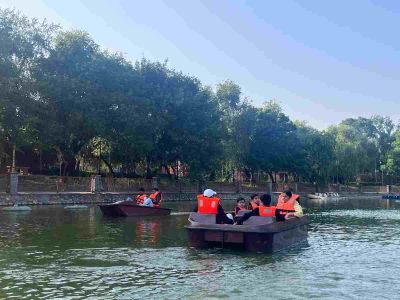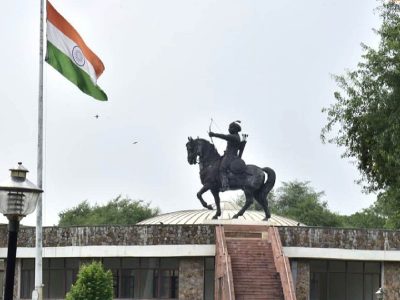Maharashtra Chief Minister Devendra Fadnavis is likely to extend financial assistance to a Marathi school in the heart of the national capital. But what makes this institution so special that it has drawn the attention of a leader from over a thousand kms away? Why does a school in Delhi continue to command the loyalty of Maharashtra’s political elite? And what is it about this nearly century-old institution that makes it more than just a place of learning?
The answer lies in the legacy of Nutan Marathi School, an institution that has been a cultural and educational cornerstone for Delhi’s Marathi-speaking community for nearly a century.
Established in 1929 by railway employees from present-day Maharashtra, the school was born out of a need to preserve language and heritage in a rapidly changing city. Over the years, it has stood as a testament to the deep ties between Delhi’s Marathi population and their home state.
But time has brought challenges. Once a thriving centre for Marathi education, the school now struggles to sustain itself. During the recently held 98th edition of the Akhil Bharatiya Marathi Sahitya Sammelan in Delhi, the Delhi Maharashtriya Educational and Cultural Society, which manages the school, sought support from the Maharashtra government. While the institution receives 95% of its funding from the Delhi government, the remaining 5% remains a constant financial burden—one that is becoming increasingly difficult to meet.
“We get 95% aid from the Delhi government to run the school. We have to manage only 5% of our expenses. We struggle to even arrange the 5% of the expenses,” informs a senior member of the school management.
For generations, sending their children to Nutan Marathi School was an article of faith for Delhi’s Marathi families, a way to keep their roots alive. But as the city’s demographics shifted, many Marathi families moved away, leaving behind an institution with fewer native Marathi students yet an undiminished cultural significance.
“Despite the decline in native Marathi students, we have continued our Marathi language classes with the same dedication,” says Gulshan Nagpal, Principal of Nutan Marathi School, who has been associated with the school since 1999.
Marathi railway community
Nearly a century ago, in 1929, a group of Delhi-based railway employees from Maharashtra came together to establish a school at Naya Bans, operating out of a small rented house. Their vision was simple: to provide quality education while ensuring that the Marathi language and culture thrived among the next generation.
As the number of students grew, so did the school’s needs. In 1951, it relocated to its current, more spacious premises in Paharganj, thanks to the efforts of Union Minister Kakasaheb Gadgil, a key figure in Prime Minister Jawaharlal Nehru’s cabinet.
“Thanks to the efforts of Union Minister late Kakasaheb Gadgil, the huge Nutan Marathi School was allotted,” states a senior school representative.
“Our school has minority language status, and Marathi is a compulsory subject up to Standard VIII. Even non-Marathi students love to study Marathi happily,” says Nagpal.
For decades, areas such as Karol Bagh, Paharganj, Aram Bagh, and Minto Road were home to a thriving Marathi-speaking community, largely made up of central government employees. Nutan Marathi School was the natural choice for their children, serving as a place where they could learn in their mother tongue while staying connected to their roots.
However, as these employees retired and moved out of government quarters, their families dispersed across different parts of Delhi-NCR. This shift meant that the next generation could no longer attend Nutan Marathi School due to the long commute.
Over the years, Nutan Marathi School has received unwavering support from Maharashtra’s most powerful political figures. Leaders like YB Chavan, Vasant Sathe, Prithviraj Chavan, and Sumitra Mahajan have shown a deep interest in the institution’s welfare, recognising its importance in preserving the Marathi identity in Delhi.
Also Read:Ram Sutar turns 100: Celebrated sculptor still shaping nation in stone and bronze
One of the most notable alumni of Nutan Marathi School is Prithviraj Chavan, former Chief Minister of Maharashtra. His father, Dajisaheb Chavan, was a member of the Lok Sabha from Karad from 1957 to 1973 and served as a minister under Nehru, Lal Bahadur Shastri, and Indira Gandhi.
“Chavan began his schooling at a local municipal Marathi-medium school in Karad. After his father moved to Delhi, Chavan joined Nutan Marathi School,” a source close to the family recalls.
It was under the leadership of YB Chavan that the school became the focal point of large-scale Ganeshotsav celebrations in Delhi.
“After the 1962 war with China, when YB Chavan became a Union Minister, he encouraged local Marathis to strengthen their cultural ties. Ganeshotsav at Nutan Marathi School became a grand annual event,” says acclaimed cartoonist and writer Madhav Joshi, who belongs to an old Marathi family in Delhi.
Even today, the school remains a gathering place during Ganeshotsav, drawing Marathi families from across Delhi-NCR who come together to celebrate and reconnect with old friends.
The second Marathi school
Delhi’s Marathi community has long been well-organised. In 1919, they formed their first cultural association, the Maharashtra Sneha Sanvardhak Samaj.
As the capital expanded and more families from Bombay Presidency moved in to work in government offices, the demand for Marathi-medium education grew. In 1957, another school—Chowgule Public School—was established at Faiz Road in Karol Bagh. Like Nutan Marathi School, it too mandated Marathi as a compulsory subject up to Standard VIII, ensuring that students remained connected to their linguistic heritage.
Beyond Nutan Marathi School, Chhatrapati Shivaji Maharaj’s presence can be felt across Delhi. The road leading from Connaught Place to Minto Road features a life-size statue of the Maratha king, installed in 1972 by renowned sculptor Sadashiv Rao Sathe from Mumbai.
In the same year, the Hardinge Stadium was renamed as Shivaji Stadium. Around the same time, the name of Minto Bridge was also changed to Shivaji Bridge, but it is still known by its old name
Sathe also designed the 12-foot high statue of Lokmanya Bal Gangadhar Tilak on the busiest crossroads of the capital, Tilak Bridge.
In 2003, a statue of Shivaji Maharaj was installed in the Parliament House, further solidifying his symbolic presence in the capital. His legacy extends to Shivaji College, founded in 1961 through the efforts of Maharashtra leader Panjabrao Deshmukh.
Curiously, despite its deep Marathi connections, Nutan Marathi School does not have a statue or bust of Chhatrapati Shivaji Maharaj—perhaps an oversight waiting to be corrected.




